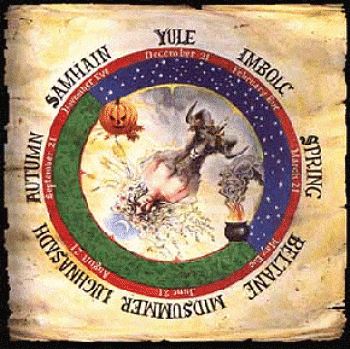








The Eight Sabbats

The Wheel of the Year
Wicca have their own set of Holy Days, just as the other religions around the world. We call them "Sabbats". They mark the passage of seasons just like any other religion, and most of them have their grounding in the Celtic/Druid Holy days.
| Yule| | Imbolc| | Eostre| | Beltane| | Litha| | Lughnasadh| | Mabon| | Samhain |
~Winter Solstice, December 20-23~
- The Pre-Christian Yuletide festival, which welcomes the dawning of the new year, and the return trip of the sun at the Winter Solstice, as it ends its winter journey, and begins it's journey back. Decorating eith evergreens occured even in the earliest of times, as a symbol of renewal and everlasting life; As it was done in many temples and still to this day in many homes and businesses across the world. The Yule log of the Druids was of oak, but the pine of Attis was used by the Teutons and in Scandinavia an ash faggot was bound within withies and burned at Yule with predictions made from the bursting of the withies. This ritual of burning a Yule Log was seen in wide-spread customs from Germany, France, England, French-speaking Switzerland, and among the Slavs, Baldur, the Scandinavian God of light and joy, would appear on the ever of December 25th. Traditional ritual includes burning the paper from the previous year containing those things youwished to have achieved. Then, writing things on a piece of paper those things you wish to do away with, then burning that piece of paper. On another piece of paper, you record those things you wish to achieve and save it for next Yule.
The Christians created "Christmas" as thier equivilant, connecting the sabbat to the birth of their "Jesus Christ", hence the name being derived from "Christ Mass".
~Oimele, Candlemas, February 1~
This festival is dedicated to Brigit, the Goddess of fire, smithcraft, inspiration and healing. It was later adopted by the Catholic church as St. Bridget's Day. This is the spring festival of Life and light, and of Purification. Most initiations happen on this day.
~Spring Equinox, March 20-23~
Marking the arrival of spring, this festical is the observation of fertility. Mother Earth and all her creatures are ready for the continuing circle of life. It's a time of balance, when all the elements within us must be brought into new harmony. It's adoption by the Christian Church borrows symbols of the Old Religion. The Easter Hare symbolizes the Goddess, and the Easter Egg represents fertility.
~May Eve, April 30 – May2~
The festival which marks the beginning of the Celtic summer. Suggested as a pastoral festival, with Midsummer as the agricultural celebration, both share similar rites. It’s the Festival of Baal, or Biel, hence Biel – tane. It’s also a period of danger and power. Like Samhain, contact of the dead and fairies are easily achieved; the latter coming out to dance and roam until Samhain.
The Christian equivalent of this Sabbat is “National Prayer Day”
~ Summer Solstice – Midsummer, June 20-23~
This is the greatest of Fire Festivals. It marks the turning of the sun from it’s summer might, to its autumnal decline. It’s the celbration of the God of Light, Mithras.
~Lammas – August 1 ~
This is the wake of Lugh, the Sun King, who dies when the grain is reaped. It’s the festival that marks the symbolic feeding on life, so that new life can come. IT’s the period of time when the Mother becomes the Reaper, diminishing the light of day which shortens its length. It also marks the passing of summer.
~Fall Equinox, September 20-23~
This is the time of the harvest. It’s a period of time to give thanks for the bountiful harvest, of taking and sorrow. It’s the moment when day and night are equal, in perfect balance. It marks the transformation of the Sun King to the Shadow Lord. Now is the period of time we must think about balance in our own lives, and that within nature.
I like to think of this as the Wiccan Equivalent to Thanksgiving Day
~ Samhuinn, Halloween, or All Hallows Eve, October 31
This is the Witches New Year. It marks the end of the beginning, and the turning of the Wheel of Life into the next year. It’s a time of cold, dearth, and darkness. Candles are lit in remembrance of dearly departed ones. It’s also a period of time when the veil between the physical and spirit world is at its thinnest, when powers are high, and communication with the dead is easiest. Shunned by the Christian church as being an evil holiday, it is anything but evil. Sumology of the present day “Halloween” ties close to that of the old ways. Costumes are worn to scare off the benign and evil spirits. Candles lit and placed within Jack – O – Lanterns which now serve as decoration, used to be placed outside of the homestead, to protect the residence from those benign spirits. The art of “trick-or-treat” keeps alive the festival which was symbolized with plenty of food, and offerings of food to those who have recently crossed into the spirit world, and have no yet returned, as all spirits do. Rejoice and cherish, as now is not only a time of death, but also the birth of the new year.
The Christian equivalent to this sabbat is All-Saints day, or All Souls. We also see similar traditions in the Spanish/Latin “Day of the Dead” celebrated November 1st.
For information concerning appropriate ritual and correspondances please see the Book of Shadows. I plan to have a more in-depth look on each Sabbat up eventually, but until then I suggest you read different sources and get your own feel for how each sabbat works. That is usually the best way to go about things.
